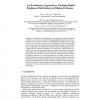Free Online Productivity Tools
i2Speak
i2Symbol
i2OCR
iTex2Img
iWeb2Print
iWeb2Shot
i2Type
iPdf2Split
iPdf2Merge
i2Bopomofo
i2Arabic
i2Style
i2Image
i2PDF
iLatex2Rtf
Sci2ools
80
Voted
PPSN
2004
Springer
2004
Springer
An Evolutionary Approach to Modeling Radial Brightness Distributions in Elliptical Galaxies
A reasonably good description of the luminosity profiles of galaxies is needed as it serves as a guide towards understanding the process of galaxy formation and evolution. To obtain a radial brightness profile model of a galaxy, the way varies both in terms of the exact mathematical form of the function used and in terms of the algorithm used for parameters fitting for the function given. Traditionally, one builds such a model by means of fitting parameters for a functional form assumed beforehand. As a result, such a model depends crucially on the assumed functional form. In this paper we propose an approach that enables one to build profile models from data directly without assuming a functional form in advance by using evolutionary computation. This evolutionary approach consists of two major steps that serve two goals. The first step applies the technique of genetic programming with the aim of finding a promising functional form, whereas the second step takes advantage of the power...
Assumed Functional Form | Distributed And Parallel Computing | Fitting Parameters | Functional Forms | PPSN 2004 |
| Added | 02 Jul 2010 |
| Updated | 02 Jul 2010 |
| Type | Conference |
| Year | 2004 |
| Where | PPSN |
| Authors | Jin Li, Xin Yao, Colin Frayn, Habib G. Khosroshahi, Somak Raychaudhury |
Comments (0)

